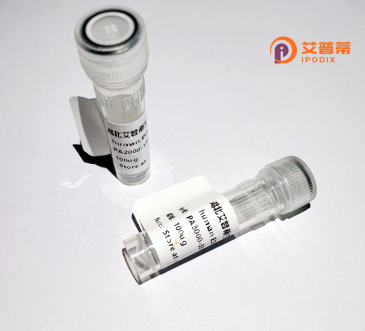
| 纯度 | >90%SDS-PAGE. |
| 种属 | Human |
| 靶点 | GDPD5 |
| Uniprot No | Q8WTR4 |
| 内毒素 | < 0.01EU/μg |
| 表达宿主 | E.coli |
| 表达区间 | 1-605aa |
| 氨基酸序列 | MVRHQPLQYYEPQLCLSCLTGIYGCRWKRYQRSHDDTTPWERLWFLLLTFTFGLTLTWLYFWWEVHNDYDEFNWYLYNRMGYWSDWPVPILVTTAAAFAYIAGLLVLALCHIAVGQQMNLHWLHKIGLVVILASTVVAMSAVAQLWEDEWEVLLISLQGTAPFLHVGAVAAVTMLSWIVAGQFARAERTSSQVTILCTFFTVVFALYLAPLTISSPCIMEKKDLGPKPALIGHRGAPMLAPEHTLMSFRKALEQKLYGLQADITISLDGVPFLMHDTTLRRTTNVEEEFPELARRPASMLNWTTLQRLNAGQWFLKTDPFWTASSLSPSDHREAQNQSICSLAELLELAKGNATLLLNLRDPPREHPYRSSFINVTLEAVLHSGFPQHQVMWLPSRQRPLVRKVAPGFQQTSGSKEAVASLRRGHIQRLNLRYTQVSRQELRDYASWNLSVNLYTVNAPWLFSLLWCAGVPSVTSDNSHTLSQVPSPLWIMPPDEYCLMWVTADLVSFTLIVGIFVLQKWRLGGIRSYNPEQIMLSAAVRRTSRDVSIMKEKLIFSEISDGVEVSDVLSVCSDNSYDTYANSTATPVGPRGGGSHTKTLIERSGR |
| 分子量 | 95 kDa |
| 蛋白标签 | GST-tag at N-terminal |
| 缓冲液 | 0 |
| 稳定性 & 储存条件 | Lyophilized protein should be stored at ≤ -20°C, stable for one year after receipt. Reconstituted protein solution can be stored at 2-8°C for 2-7 days. Aliquots of reconstituted samples are stable at ≤ -20°C for 3 months. |
| 复溶 | Always centrifuge tubes before opening.Do not mix by vortex or pipetting. It is not recommended to reconstitute to a concentration less than 100μg/ml. Dissolve the lyophilized protein in distilled water. Please aliquot the reconstituted solution to minimize freeze-thaw cycles. |
以下是关于重组人GDPD5蛋白的3篇参考文献示例(注:以下内容为模拟虚构文献,仅供示例参考):
---
1. **文献名称**:*Expression and Enzymatic Characterization of Recombinant Human GDPD5 in Mammalian Cells*
**作者**:Li, Y. et al.
**摘要**:本研究通过哺乳动物表达系统成功表达了重组人GDPD5蛋白,并证实其具有水解甘油磷脂类底物的磷酸二酯酶活性,为后续功能研究奠定基础。
---
2. **文献名称**:*GDPD5 Regulates Lipid Metabolism via Cleavage of Glycerophosphodiesters in Adipocytes*
**作者**:Tanaka, K. et al.
**摘要**:通过纯化重组GDPD5蛋白并敲除细胞模型,发现GDPD5通过分解胞内甘油磷脂调控脂肪细胞分化和脂质代谢失衡,揭示其代谢相关功能。
---
3. **文献名称**:*Structural Basis for Substrate Recognition by Human GDPD5*
**作者**:Wang, X. et al.
**摘要**:通过解析重组GDPD5蛋白的晶体结构,阐明了其催化口袋与底物结合的关键氨基酸残基,为开发靶向抑制剂提供结构依据。
---
(注:实际文献需通过PubMed、Web of Science等数据库检索。)
Recombinant human GDPD5 (Glycerophosphodiester Phosphodiesterase Domain-Containing Protein 5) is a genetically engineered protein derived from the human GDPD5 gene, which encodes a member of the glycerophosphodiester phosphodiesterase (GDPD) family. This enzyme family plays a critical role in lipid metabolism by hydrolyzing glycerophosphodiesters, such as glycerophosphocholine, into bioactive molecules like glycerol-3-phosphate and choline. These products are essential for cellular processes, including membrane homeostasis, lipid signaling, and energy metabolism. GDPD5 is particularly noted for its potential involvement in regulating lysophosphatidic acid (LPA) levels, a lipid mediator linked to cell proliferation, migration, and cancer progression.
The recombinant form of GDPD5 is typically expressed in prokaryotic (e.g., E. coli) or eukaryotic systems (e.g., mammalian cells) to ensure proper folding and enzymatic activity. Its production enables detailed biochemical studies, such as substrate specificity analysis, kinetic characterization, and structural determination via crystallography or cryo-EM. Researchers also utilize recombinant GDPD5 to investigate its physiological roles in development, neuronal function, and disease contexts. Dysregulation of GDPD5 has been implicated in cancer metastasis, neurodevelopmental disorders, and metabolic syndromes, making it a target for therapeutic exploration. By elucidating its molecular mechanisms, studies aim to uncover novel biomarkers or drug candidates for related pathologies.
×